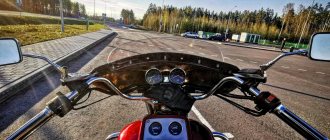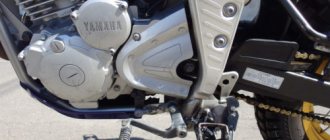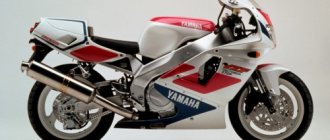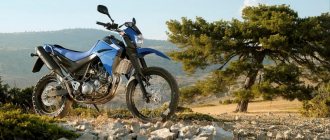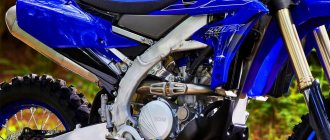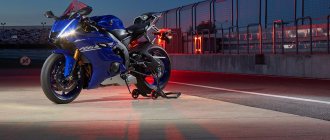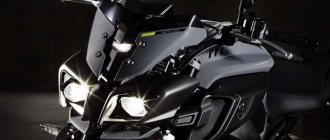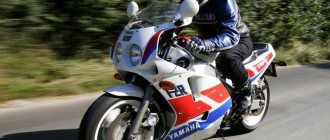Bike features
Here's why the Yamaha FJ 1200 outperforms many of its competitors:
- Convenient for traveling together due to its impressive dimensions;
- stability on the road, resulting again from size and weight;
- low cost compared to top sports tourists.
Of course, this model cannot be called the best representative of the class. There are many reasons for this, and one of the undeniable ones is that the engine is too voracious, consuming at least 6.5 liters of fuel during calm, measured movement along a country road. What can we say about the mixed cycle, the city and the like.
Hello again. Almost a couple of years ago I tried to talk about this carriage from the 80s, the motorcycle that gave its heart to the XJR. But that time nothing came of it, because... the technology didn’t allow it, and having slept with my thoughts, I suspected a trick somewhere. I realized that not everything I said is what a motorcycle is. But now it’s time to finish what we started.
The main thoughts are presented in the video, here I will say that its history began with the index 1100 and not at all as a sports tourist, but as the fastest Yamaha road motorcycle at that time. It appeared when all manufacturers were looking for answers to emerging challenges. Bans on two strokes and increased power in 4-stroke engines. That’s why the motorcycle received some of the bells and whistles straight from the Moto GP and became, perhaps, the company’s first superbike.
But let's return to the FYZH 1200... Its dual nature is manifested in the landing with a rather strong slope and a powerful engine for its age, on the one hand, and soft suspension on the other. This is influenced by the geometry and size of the wheels. Do you know a lot of motorcycles with 130 horsepower, sport bias and 150 16 rear wheel? I'm not very good.
Overall, this leads to a very strange range of feelings and emotions when you control it. The motorcycle is soft and comfortable, rocking like a ship on the waves of Russian roads. At the same time, it does not have the sharpness and precision of control characteristic of motorcycles with tight suspensions, but it is not annoying or intimidating in turns, it is easy to fit and maintains its trajectory, while “swimming” at the same time. The main thing is not to forget that there is a lot of torque on the rear wheel, and it can be torn off.
At low speeds, some skill is required, because the bike tends to fall inside the turn. The dynamics are very decent, a couple of hundred appear on the speedometer quickly, i.e. there will always be enough traction reserve. Due to its original sportiness, the mot is quite narrow and perfectly stitches corks in a straight line. For “maneuverable combat” with them, as I said, you need skills and abilities so as not to overwhelm 270 kilos.
In terms of fit, it is advisable for people taller than 190 cm to measure their legs so that they fit into the niches. On the contrary, it may be very suitable for short people; 78 cm across the saddle hints at this.
But the main thing is that now these motorcycles are quite old, but among them there are also freshly fitted, very suitable examples for very reasonable money, which makes them a very good choice for those who are not afraid of a tilted seat.
As usual, details can be found here:
Dimensions and weight
As for weight, this representative of the class, although not out of the norm, is definitely one of the heaviest. Even its dry weight is 250 kg, let alone loaded, if its tank volume is 22 liters. The wheelbase is 1490 mm, but the seat height is average and reaches only 780 mm.
Brief history of the model
1986 - start of production and sales of the Yamaha FJ 1200 model. First generation. Model: Yamaha FJ1200S /FJ1200SC (USA). Factory designation: 1UX/1WJ.
Model: Yamaha FJ1200 (Europe). Factory designation: 1WH (France), 1YK (Switzerland), 1XJ (Germany), 1TX (UK).
1987 - no significant changes. Model: Yamaha FJ1200T /FJ1200TC (USA).
Model: Yamaha FJ1200 (Europe). Factory designation: 1WH (France), 1XJ (Austria), 1TX (UK).
1988 - second generation of the model. This year's models are only available in Europe. The Yamaha FJ 1200 loses its Anti-dive system, gets new 4-piston front calipers and 298 mm ventilated brake discs, a 2-piston rear caliper, digital ignition, a fuel pump and a 17′ front wheel. Model: Yamaha FJ1200 / FJ1200U (Europe). Factory designation: 3CY1 (Switzerland), 3CX1 (France), 3CV2 (Spain), 3CW1 (Austria), 3CV1 (UK), 3GP1 (other European countries).
1989 - no significant changes. The model is again available on the US market. Model: Yamaha FJ1200W /FJ1200WC (USA). Factory designation: 3SK.
Model: Yamaha FJ1200 / FJ1200W (Europe). Factory designation: 3GP2.
1990 - third generation of the model. The appearance of modifications with ABS (FJ1200A). Model: Yamaha FJ1200A /FJ1200AC (USA).
Model: Yamaha FJ1200 / FJ1200A (Europe). Factory designation: 3CY2 (Switzerland), 3CX2 (France), 3CV7 (Spain), 3CW2 (Germany), 3CV6 / 3GP3 (other European countries).
1991 - The Yamaha FJ1200 is also available in the Japanese market. Instead of an aluminum pendulum, the model gets a steel one. Model: Yamaha FJ1200B /FJ1200BC (USA). Factory designation: 4AH.
Model: Yamaha FJ1200 / FJ1200A / FJ1200AD / FJ1200B (Europe). Factory designation: 4BS1 (Switzerland), 3YY1 / 3YY2 (France), 3XW4 (Spain), 3YA2 / 3YA1 (Germany), 4BS2 / 3XW2 / 3XW1 / 4CR3 / 4AH3 / 4CC1 (other European countries).
Model: Yamaha FJ1200 / FJ1200A (Japan). Factory designation: 4CC1 / 4CC2.
1992 - no significant changes. Model: Yamaha FJ1200D/DC, FJ1200AD/ADC (USA). Factory designation: 4CR.
Model: Yamaha FJ1200 / FJ1200A / FJ1200D (Europe). Factory designation: 3YY3 / 3YY4 (France), 3YA3 / 3YA4 (Germany), 3XW6 (Spain), 4BS3 / 4BS4 / 3XW5 / 3XW7 / 4AH6 (other European countries).
1993 is the last year of sales of the model in the USA. The Yamaha FJ 1200 is being discontinued but is still available on the European market. Model: Yamaha FJ1200AE/FJ1200AEC (USA).
Model: Yamaha FJ1200 / FJ1200A / FJ1200E / FJ1200AE (Europe). Factory designation: 3XW8 (Spain), 4CR6 / 4AH9 (other European countries).
1996 was the final year of Yamaha FJ1200 sales in the UK.
Chassis and brakes
Disc brakes do a good job. The rear uses a single disc, while the front uses a pair. The calipers vary, with four-piston units at the front of the bike and a two-piston option at the rear.
The rear suspension is pendulum and has a monoshock absorber. The front telescopic fork has a fairly large stroke of 150 mm. The tubular frame is made of steel, and the wheel rims are, of course, cast, as befits sports touring models.
Main generations of Yamaha FJ 1200
1986-1987 - first generation. Models from these years closely resemble the FJ1100. The motorcycle has no fuel pump, is equipped with an Anti-dive system, has a 16′ front wheel, 2-piston front calipers, 1-piston rear caliper, non-ventilated brake discs, TCI analogue ignition and aluminum rear suspension.
1988-1989 - second generation. Motorcycles of these years do not have an anti-dive system, are equipped with a 17′ front wheel, 4-piston front calipers and 298 mm ventilated discs, a 2-piston rear brake, a fuel pump and TCI digital ignition.
1990-1996 - third generation. In addition to the basic version, versions with ABS are also available (FJ1200A). Instead of an aluminum rear suspension, the model gets a steel one.
The model was produced until 1993, after which it was discontinued. Sales of new motorcycles continued until 1996 (UK). In 2001, a new model, the Yamaha FJR 1300, was introduced as a successor to the Yamaha FJ 1200.
Links[edit]
Notes[edit]
- ^ a b
Haynes 0.5 - Haynes 2.4
- Clymer p.216
- Haynes 5.2
- Haynes 2.5
Bibliography[edit]
- Ahlstrand, Alan and Haynes, John H. Yamaha FJ1100 and 1200 Fours '84 - '96
. Sparkford, UK: Haynes Publishing, 1996. ISBN 1-85960-229-0. - Clymer, Yamaha FJ1100 and FJ1200 1984–1993
. Overland Park, Kansas. Intertec Publishing, second edition 1996. ISBN 0-89287-605-0. - Brown, Roland The Definitive History of Fast Bikes
. Bath, UK: Parragon Books, 2004. ISBN 1-4054-3732-4.
FJ1100[edit]
Yamaha produced the FJ1100 for the 1984 and 1985 model years. This class is characterized by maintaining sportiness while integrating more street-friendly ride characteristics, including good agility, as well as long-distance comfort, such as a more upright seating configuration designed to reduce back strain and a large fairing to reduce fatigue from wind resistance. The emphasis is on balancing utility and sport rather than a pure performance focus. The car was noticeably narrower than many of its contemporaries, Yamaha achieved this by placing the generator behind the cylinders instead of the more usual position at the end of the crankshaft. [1]
1984 FJ1100 with custom seat
FJ1200[edit]
In 1986, Yamaha decided to upgrade the FJ1100 by slightly increasing engine displacement and adding upgraded suspension and other components. The result was the FJ1200. Peak power output was increased slightly to 130 hp. (97 kW) with 125 hp (93 kW) FJ1100, [ citation needed
] The FJ1200 had lower to mid-range torque.
The FJ1200 was produced in three main sequential versions (1TX, 3CV and 3XW), each updated version benefiting from improvements to the bodywork, front and rear suspension components and the addition of an additional ABS version (FJ1200A).
from 1991 to 1996, when Yamaha discontinued the FJ1200 in the UK. The model was discontinued in the United States in 1993. Competitors in the market during its production years included the BMW K100RS, Suzuki 1100 Katana and Kawasaki Ninja ZX-10. [1]
Engine[edit]
The FJ1200 uses an air-cooled four-cylinder inline engine. Sixteen valves are actuated by a chain-driven double overhead camshaft; Valve clearances are adjusted using shims. Four constant speed carburetors are mounted in line behind the cylinders and feed each cylinder through short intake manifolds. The four exhaust pipes connect to a box under the engine where the gases are separated and exited through two mufflers (silencers). The crankshaft is connected directly to the clutch; no balance shaft is used. Starting is carried out only by an electric starter. Lubrication - wet sump with trochoid pump; an oil cooler helps with cooling.[2] Both the FJ1100 and FJ1200 were equipped with an optional evaporative emission control system to meet California emissions regulations. [3]
1990 FJ1200 Model 3CV with standard windshield
Transfer[edit]
The FJ1200 uses a five-speed constant-mesh close-ratio sequential manual transmission. Wet clutch with multi-plate diaphragm spring and hydraulic drive. The main drive is an O-ring chain and sprockets.
Chassis[edit]
The frame of the FJ1200 is made from mild steel box section and uses a layout around the perimeter, fairing and upper rear using separate cylindrical pumping subframes. The rear shock sits vertically behind the engine and connects to an extruded aluminum alloy swing arm (note: later 3XW models have a mild steel swing arm) via a series of forged aluminum rocker arms. The 17-inch front wheel is supported by a 41mm spring and oil-damped fork. The FJ1100 and earlier FJ1200 models were equipped with adjustable dive blocks and a smaller diameter 16-inch wheel. The FJ1100 and early FJ1200 used dual ventilated disc brakes at the front with a single ventilated disc at the rear. The FJ1200, 3CV and 3XW used solid front discs, but retained the rear vented disc, and the front brake calipers were upgraded to a four-piston design. The FJ1200A used an anti-lock braking system. A full fairing protects the driver, and fixed windshields of varying heights are available as an option. [4]
FJ1200 with ABS brakes
Electrical system[edit]
The FJ1200 has a standard 12 cylinder electrical system with an alternator and starter mounted behind the cylinders. Nippondenso Transistor Controlled Ignition (TCI) is used in combination with two coils. A Yamaha self-off indicator is used and a variable resistance sensing system is used to monitor the engine oil content with corresponding warning lights. There is a large fuel gauge and a low fuel warning light. A digital clock is also installed. A safety feature on the FJ1200 is that the engine ignition is cut off if first gear is selected with the sidestand down, which is now common on modern motorcycles. [5]
